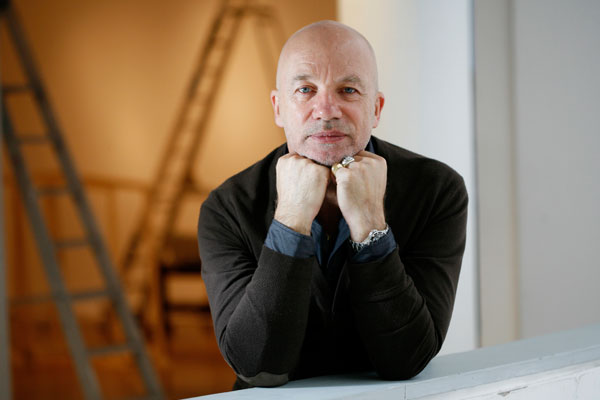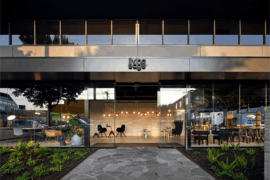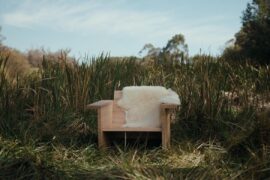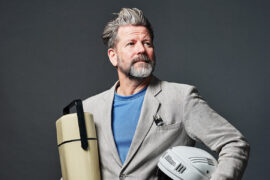That design and architecture should make people’s lives more pleasurable is perhaps unquestionable. How, exactly, is more subjective. Nigel Coates made some suggestions at INSIDE (World Festival of Interiors). Narelle Yabuka reports.

October 16th, 2013
Throughout his career, Nigel Coates has explored artistically driven work that weaves through and around the bounds of what is traditionally considered to be ‘architecture’ and ‘design’. Fuelled by both instinct and intellect, the figurative and the abstract collide and blend in his architecture, interiors, and product designs.
The Body Zone for London’s Millennium Dome (2000) contained “cinematically conceived evocations of the body”
‘Designing for Delight’, his keynote presentation at INSIDE (World Festival of Interiors) on 2 October 2013, provided a good opportunity to explore how this visionary designer conceives of the delightful or pleasurable in the designed context. Often, it emerged, delight seems fused with a sense of the unexpected.
As does his work, Coates’ keynote presentation danced around the abstract and required the members of the audience to draw some conclusions for themselves. The presentation was perhaps less a seminar, and more a piece of prose.
‘Picaresque’ was part of the exhibition ‘Kama: Sex and Design’ (2012 to 2013) at the Triennale di Milano, and explored the desirability of objects
Coates began his presentation by asking the audience to think about how architecture might seem to “ask us to film it.” That is, how can we be fascinated, seduced, and engaged by architecture? This question introduced the notion of narrative – a language of design, he said, that builds on people’s everyday experiences, and which his work often embraces.
A key site of delight for Coates himself is his sketchbook, he revealed. A drawing is a conversation, he said, and the sketchbook provides an important opportunity to express his creativity to himself. It allows an instinctual way of exploring the delight of space, he said, with reference to a drawing he produced for a 1984 exhibition.
A drawing for a house for Derek Jarman (1984) was a means of exploration and communication
Coates was invited to design an imaginary building for a client of his choice. He represented the house he designed for film director Derek Jarman through a non-conventional technique – neither axonometric nor plan nor section.
His drawing, he said, “is more like a map mixed with X-ray images. It’s an accumulation of spaces that are not afraid to open themselves out and tell the viewer how they relate to one another. I think it’s a kind of childish instinct… but it also is a knowing one” that allows the building to be seen more clearly.
Caffè Bongo in Tokyo (1986) – a dramatic pop-classical collage
For Caffè Bongo, situated in a Parco department store in Tokyo (completed in 1986), Coates audaciously plunged a plane wing through the space and its front window. The design theme was based on Frederico Fellini’s film La Dolce Vita, and aimed to reflect the love affair that Japan was having with old Europe. Said Coates, “It was exciting to do, delightful to realise, but it also delighted the people who visited it.” Designing it, he said, involved “some kind of instinctual response.”
The National Centre for Popular Music (1999) created an icon for Sheffield
The National Centre for Popular Music (now the Hub) – a composition of four tilted steel drums in Sheffield, UK – embodies the impression of movement while also generating the opportunity for a spatial experience that fascinates with its non-hierarchical and relatively directionless interior.
The Geffrye Museum extension (1998) appends traditional linear buildings with a curved trajectory
Similarly, the Geffrye Museum extension in Shoreditch, London (1998) “plays another game that is generated by the dynamics of space,” explained Coates. The new wing is entered through existing buildings, and one’s path through its horseshoe-shaped plan can only be deciphered as it is experienced.
The Mixtacity display at Tate Modern (2007) presented an expressive architecture for the Thames Gateway
In the Mixtacity project of 2007, Coates proposed fantastical buildings for the Thames Gateway by combining bricolage with pseudo-parametric surfaces. He described the scheme as “a kind of club sandwich of modes of thinking” forged from a narrative inspiration.
The design for the Slamp Stand for Euroluce 2013 incorporated oversized, tilting picture frames
For the 2013 Euroluce fair in Milan, Coates designed a stand for the Italian lighting company Slamp, for which he is Creative Director. With tilting oversized picture frames, he played on the ‘experiential aesthetic’ of the art gallery.
In an interview published in The Guardian in 2010, Coates described himself as a frustrated moviemaker. “I want to unfold what it means to love architecture,” Coates had said at the start of his presentation. To love architecture like one can love a film sounds delightful. Could there be a goal that is simultaneously more profound and simple?
Nigel Coates Studio
nigelcoates.com
INSIDE (World Festival of Interiors) was held concurrently with the World Architecture Festival at Singapore’s Marina Bay Sands from 2–4 October 2013.
INDESIGN is on instagram
Follow @indesignlive
A searchable and comprehensive guide for specifying leading products and their suppliers
Keep up to date with the latest and greatest from our industry BFF's!

For Aidan Mawhinney, the secret ingredient to Living Edge’s success “comes down to people, product and place.” As the brand celebrates a significant 25-year milestone, it’s that commitment to authentic, sustainable design – and the people behind it all – that continues to anchor its legacy.
The new range features slabs with warm, earthy palettes that lend a sense of organic luxury to every space.
Afficionados of the Nod are now offering their in-stock wallpapers by the metre.

Leading Australian furniture manufacturer, MAP, reboots their design brand with a new collection available at Schiavello.

Design that speaks many languages is to be treasured and enjoyed. Trent Jansen tells a story of design collaborations and connections through his work on Country with friends and artists who bring the perspective of First Nations people to the fore.

As Vivid Sydney wraps for another sensational year, Gillian Serisier spoke with Mandylights lighting designer Tom Wightwick, one of the incredible minds behind recent light events including Sydney World Pride (Opening Ceremony, Domain Dance Party, Rainbow Republic), Poem of the Eternal City (a major theatrical production in Uzbekistan) and this year’s Vivid.
The internet never sleeps! Here's the stuff you might have missed

Mark Tuckey X Main Studio embrace the future with a new range of furniture that showcases the beauty of agroforestry timber.

‘What a Ripper!’ by comedian and architecture advocate Tim Ross explores Australia’s rich legacy of local product design.